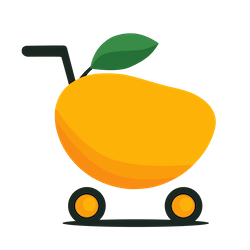Try this productivity improvement plan: Set clear goals, audit your week, commit to daily actions, schedule deep work, batch tasks, review weekly, and build tiny habits to make consistent progress without overwhelm or complex systems.
–
If you’re looking for The SAVINGS Method that breaks down productivity into realistic, daily actions, jump to this section.
–
Productivity Improvement Plan (explained in more detail)

Productivity improvement plans let you map out key goals, set clear priorities, and split your work into smaller steps.
Most people never use a structured plan. If you try to keep everything in your head, you drop projects and lose track fast.
Simplicity matters. Pen, paper, or a single notes app will usually work better than any new system. Your plan’s job is to make it obvious what you need to do and what’s getting skipped.
Solo entrepreneurs have packed days – you’re customer support, project manager, billing, and marketing. Juggling all those duties gets rough.
Plans are not just to-do lists. They’re honest checklists, written routines, and a “why” behind each priority. If you spend every morning lost in email or admin, your plan needs to help you spot that and fix it.
The simpler your system, the easier it is to keep using it.
Why Productivity Plans Matter for Solopreneurs & Creators
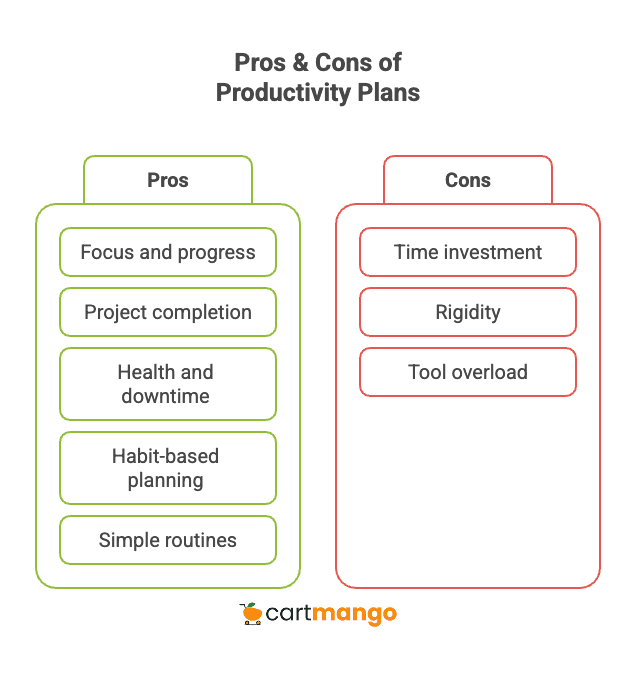
If you run everything yourself, distractions are everywhere. Email, tech support, social media, bills, content – all these jobs land on your desk. You can finish a workday feeling busy but not much closer to real progress.
Without a plan, big projects stall out. Ideas get stuck waiting for “free time,” which never comes. But breaking down these projects makes them easier to start and finish. A good productivity improvement plan helps you break major goals into smaller steps.
- Monday could be for updating your shop,
- Tuesday for writing copy,
- Wednesday to sort through analytics.
- When you can see each chunk, you keep moving.
Your plan should include health and downtime. If you skip breaks, burnout hits harder.
Build off your own habits first. Old-school planners, sticky notes, and digital calendars work. Don’t switch up tools unless your current method is failing.
The best routines tend to be plain and repeatable.
Key Elements of an Actionable Plan
- Set clear goals. Write “publish my online course by Friday.”
- Audit distractions: Try tracking every task for three days. Where does your time disappear? What jobs never get done?
- Pick one or two vital daily actions. Don’t overload your checklist. Focus on the smallest step that leads forward.
- Hold yourself accountable. Use a calendar, habit tracker, sticker chart, or digital list. Google Keep, Todoist, and Trello can make simple lists easy and mobile.
- Review weekly. Each Sunday, write what went right and what flopped. Commit to one change for next week.
- Use time blocks. Schedule “deep work” first in the day; leave admin and small jobs for after lunch.
- Automate only the tasks that drag out repeatedly – sorting emails, uploading files, regular reminders.
- Create manual checklists or start digital only if it makes your day easier.
Clear priorities improves what you get done. Simple systems are easier to fix when something breaks. Don’t let apps become a chore.
Ask yourself every month: Is my plan helping, or getting in my way? Revise as needed.
The SAVINGS Productivity Improvement Plan
S = Set goals
A = Audit week
V = Validate actions
I = Invest deep work
N = Narrow tasks
G = Gain insights
S = Start habit
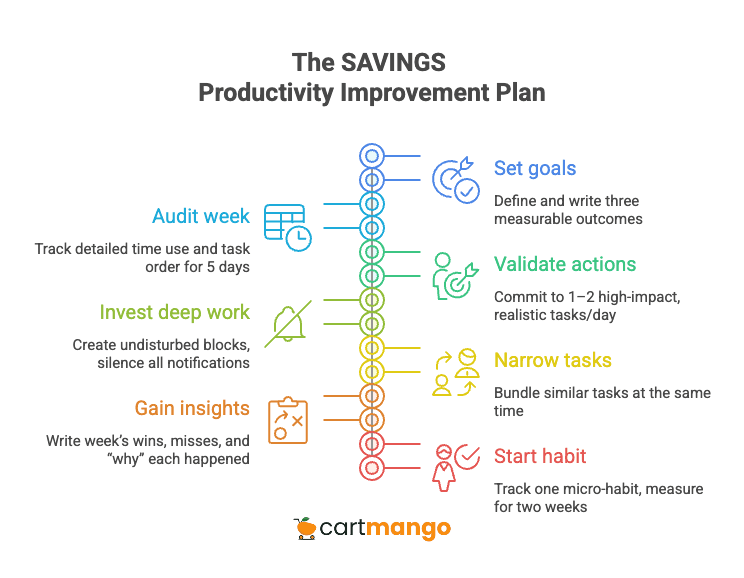
| Step | Action | How to Do It | Outcome |
|---|---|---|---|
| 1 | Set goals | Define and write three measurable outcomes | Know exactly what matters |
| 2 | Audit week | Track detailed time use and task order for 5 days | Spot bottlenecks, real patterns |
| 3 | Validate actions | Commit to 1–2 high-impact, realistic tasks/day | Build focus, get momentum |
| 4 | Invest deep work | Create undisturbed blocks, silence all notifications | Maximize your productivity during peak hours |
| 5 | Narrow (batch) similar tasks | Bundle admin/content/support at same time | Fewer energy drops, smooth flow |
| 6 | Gain insights | Write week’s wins, misses, and “why” each happened | Quick, targeted improvement |
| 7 | Start habit | Track one micro-habit, measure for two weeks | Easy progress, less resistance |
Begin with a method that feels natural. If you’re already jotting things down in a paper planner or digital calendar, build from there.
Don’t overhaul your system unless it’s stopping you from getting things done. Simplicity encourages consistency.
If you want to go digital, you can add apps like Toggl to track time, Google Calendar for setting protected work blocks, or Notion if you want something highly customizable for goals, habits, or detailed notes.
1/ Set clear goals for the week.
Spend at least 10 minutes before Monday to identify your 3 most important outcomes.
Replace vague hopes (“be productive”) with written, measurable actions – like “record two course videos” or “reach out to five potential clients.”
Make each goal something you can check off, not something you’ll have to guess about.
2/ Track your actual week in real life.
For 5 straight days, write down your start/stop times and what you truly worked on.
Did you spend 2 hours researching instead of writing? Note the detail. At the end, review the log for hidden patterns: Do admin distractions pile up in the morning? Are afternoons your “lost” zone?
3/ Choose and commit to 1–2 daily non-negotiables.
Use your audit to set daily priorities that match your peak focus windows.
On Tuesday, you might pick: “Finish the About page copy before 11 a.m.,” and “batch client replies before 4 p.m.”
Write only the essentials. Leave room in your list for unexpected events.
4/ Build protected work blocks for deep concentration.
Look at your log and find uninterrupted hours. Put your phone on Do Not Disturb. Block notifications (Slack, email, social apps) on your browser and phone.
If you work from home, let roommates or family know these blocks are “no interruption” times.
Add these sessions as appointments to your calendar, like real meetings.
5/ Batch repetitive or lower-value work.
Many solo creators lose hours by context switching.
Pick a set time for grouping tasks: Friday afternoon could be your finance/check-in/billing block, and Wednesday midday your social scheduling slot.
Use labels or color codes in your planner to see theme days at a glance. Completion feels easier when similar energies align.
6/ Keep a weekly reflection ritual.
Every Sunday, set aside 20 minutes to review what stuck and what didn’t.
Go beyond a simple checkmark. Write a sentence on “why” you missed or completed each big goal.
Did you underestimate? Was there an urgent distraction? These notes are your learning tool. Use a notebook, a Notion page, or your phone’s journal app.
7/ Experiment with one tiny, trackable habit at a time.
Don’t flood your system with big changes. If you want to build a reading routine, try “read 2 pages after lunch” every day for two weeks.
Use a simple tracker like pen and paper, a habit app, or a recurring Google Calendar reminder. After two weeks, if the routine feels natural, expand it slightly, or swap for a new micro-habit.
More tips
- Don’t skip the “why” behind what you accomplish. For every high or low result, jot a sentence or bullet explaining the cause.
- Use stickers, highlights, or color if you’re visual. It gives a fast read on how you’re doing at a glance.
- When you run up against repeated failures to achieve, review your commitments: Are tasks realistic in size? Are you putting key work at your best energy hours, or just squeezing it in where you can?
- Reserve at least one small slot a week to learn about or try something new. This isn’t “productivity for productivity’s sake”. Fresh routines help you adapt fast when things change.
- Share your weekly goal breakdown or progress log with a peer, accountability buddy, or even your future self (written note). This builds in low-key outside motivation.
Give each part of your workflow a trial. Let yourself make mistakes. Those details speed up learning and let you patch gaps in future weeks. Over time, your framework will feel custom because… well, it is. All the best plans are.
7 Productivity Tactics
Effective productivity comes from choosing tactics that fit your daily habits, not chasing every trendy method. You’ll see a lot of advice about “the best trick,” but the reality is most progress comes from a few fundamentals done well.
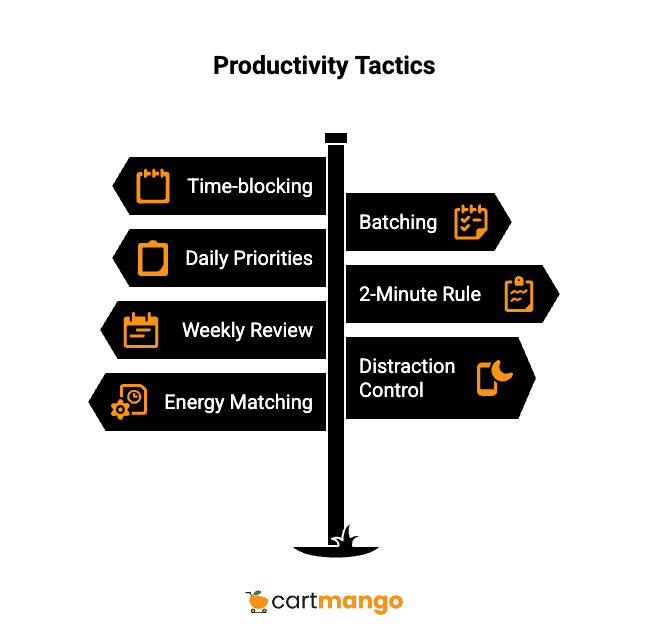
| Tactic | Action | When to Use | How to Track |
|---|---|---|---|
| Time-blocking | Reserve focused blocks for your biggest priorities | Deep work, projects | Calendar, planner, app |
| Batching | Handle similar tasks together for efficiency | Repetitive admin, emails | Checklist, “theme day” label |
| Daily priorities | List two must-do items at the start of each workday | Every morning | Simple paper note, app task |
| 2-Minute Rule | Instantly tackle tasks needing less than two minutes | During transitions | Habit mark, quick log |
| Weekly review | Evaluate your previous week and plan next steps | Sundays, quiet times | Journal, weekly calendar |
| Distraction control | Silence notifications, clear your physical and digital space | Deep focus times | Written cues, phone timers |
| Energy matching | Do complex work when you’re naturally most alert | High-impact tasks | Mark optimal hours in planner |
Time-blocking
Time-blocking means you block out time on your calendar. Say, 9am to 11am – for just one task, with no phone, email, or side work. Many find that protecting “deep work” hours increases output and reduces stress.
Batching
Batching is about grouping. Set one hour for all emails, another for invoicing, and a third for social media posts. By focusing on one type of task, you use less energy switching gears and finish faster.
Daily priorities
Daily priorities is the tactic of writing just two “musts” each morning. You keep them visible on your desk or phone. Once those two are done, anything else is a bonus, which helps reduce overwhelm.
The 2-Minute Rule
The 2-Minute Rule turns small, nagging jobs into quick wins. Whenever you spot something needing little time, like responding to an email, tidying your workspace, or sending a reminder… you do it right away to keep your plate clear.
Weekly review
Weekly review means you look back, ask what went well, what failed, and what habits need adjusting. You can do this in a notebook or digital journal. It’s not about blaming yourself, just fine-tuning the next week’s plan.
Distraction control
Distraction control includes muting apps, closing tabs, putting your phone away, or even putting on noise-cancelling headphones. Physical cues like a sticky note saying “FOCUS” can remind you to stay present.
Energy matching
Energy matching means observing when during the day you’re sharpest… maybe early morning, maybe late at night. Plan your hardest or most creative jobs for those windows, and save routine work for other times.
–
Try 2 or 3 tactics, stick with them a week, then evaluate. Over time, add or swap tactics based on what helps most. Consistency will bring real results.
Common Mistakes & How to Fix Them
Mistakes show your system is real and being used.
Here’s a rundown of what stalls many people:
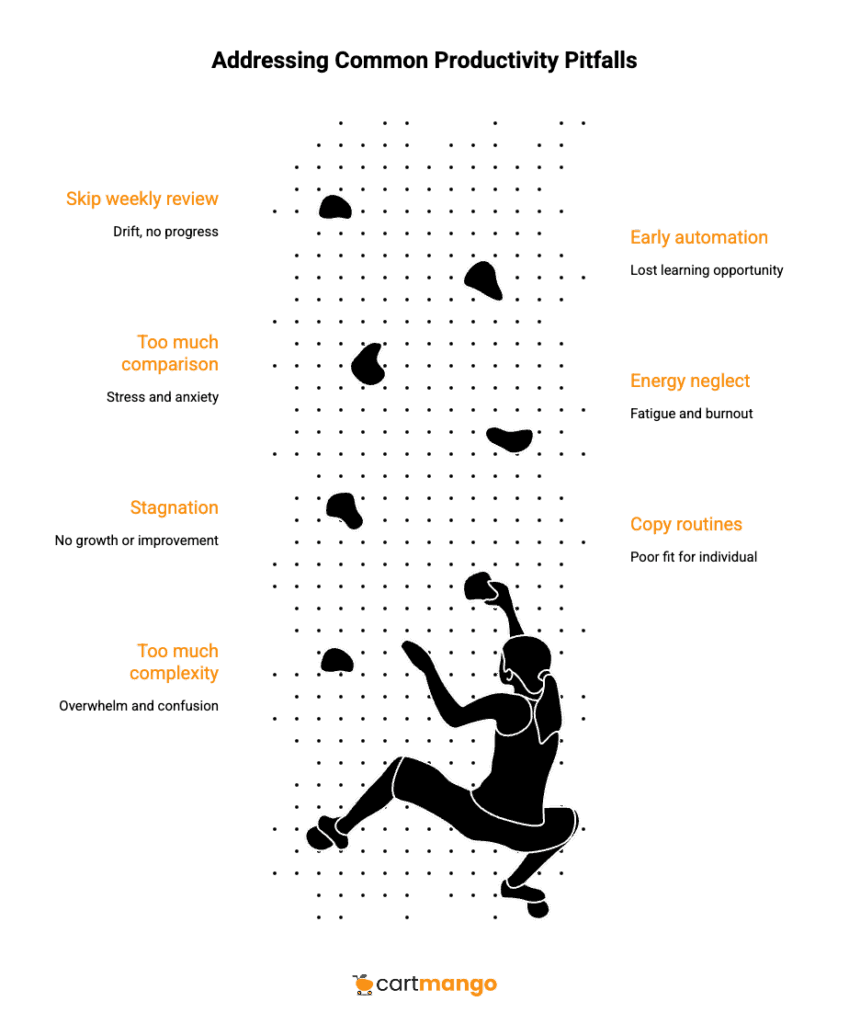
| Mistake | What Happens | Fix |
|---|---|---|
| Too much complexity | Overwhelm / confusion | One-page plan or simple list |
| Copy routines | Poor fit | Use only what feels right |
| Stagnation | No growth | Change one thing per month |
| Energy neglect | Fatigue / burnout | Schedule hard jobs for peak hours |
| Too much comparison | Stress/anxiety | Track your progress only |
| Early automation | Lost learning | Do tasks manually first |
| Skip weekly review | Drift, no progress | Set reminders in calendar |
If your system is failing, cut out the extras. Track only the essentials for two weeks then add back anything missing. Don’t compare your planner to others. Productivity is personal.
Effective Productivity Planning for Teams and Individuals
Now let’s talk about productivity in the workplace. If you want to improve productivity across your workforce, an effective productivity plan is essential, whether you’re solo or managing a group.
Improvement strategies such as time management, process optimization, and setting deadlines make business leaders better equipped to create an effective roadmap.
Increase productivity by first identifying busywork and repetitive tasks that waste valuable time.
Processes to reduce these include automating tasks with project management software, streamlining communication to avoid unnecessary meetings, and using improvement strategies designed to keep teams on track. Effective communication means you and your external partners share ideas without confusion, reducing the chances that disorganize will slow progress.
Develop a productivity strategy based on team needs and your own work style. Allocate time for decision-making and initiative. This helps workers spend time on tasks closer to your goals.
For remote work, workforce and workplace productivity depend on minimizing distractions and promoting ways to boost morale. Career advancement often relates to how well team productivity is promoted; when employees help your team work better, everyone benefits.
With a focus on productivity improvement, teams and individuals can refocus, reevaluate, and always look for new ways to boost productivity. Create a productivity routine that emphasizes work-life balance, creates space for effective productivity, and keeps project deadlines realistic.
Morale and customer satisfaction can be enhanced by improvement strategies that value every worker’s contribution… not just the number of employees but how they support business outcomes.
Your Turn to Create a Productivity Improvement Plan
Daily habits move the needle more than big changes or fancy software. Use your planner, notes app, or calendar as your main tool. Write three goals. Take steps each day, mark off what you finish. Review weekly, adjust your routine, and improve one thing at a time.
Your system should make life easier, not harder. If you’re comfortable now, stick with it. Don’t seek perfect. Focus on real progress.
Related Reading
- SendOwl vs Gumroad: The Recurring Revenue Black Hole (2026)
- Gumroad vs Sellfy: The Vendor Lock-in Cage (2025)
- Gumroad vs Payhip: The Hidden Trap for Creators (2025)
- ThriveCart vs SamCart – The Subscription Hostage Trap (2025)
- 8 ThriveCart Alternatives & The Lifetime Pricing Paradox (2025)
- 8 SamCart alternatives + Subscription hostage (2025)
- The GENTLE Method: Soft marketing for creators
- How Far in Advance Should You Promote a Webinar?
- The SAVINGS Method: The Productivity Improvement Plan for Creators
- 9 Questions to Ask: How to Hire a Digital Marketing Agency
